Humanitarian Assistance Case Study 2022
VerifiedAdded on 2022/08/21
|9
|2443
|17
AI Summary
Contribute Materials
Your contribution can guide someone’s learning journey. Share your
documents today.
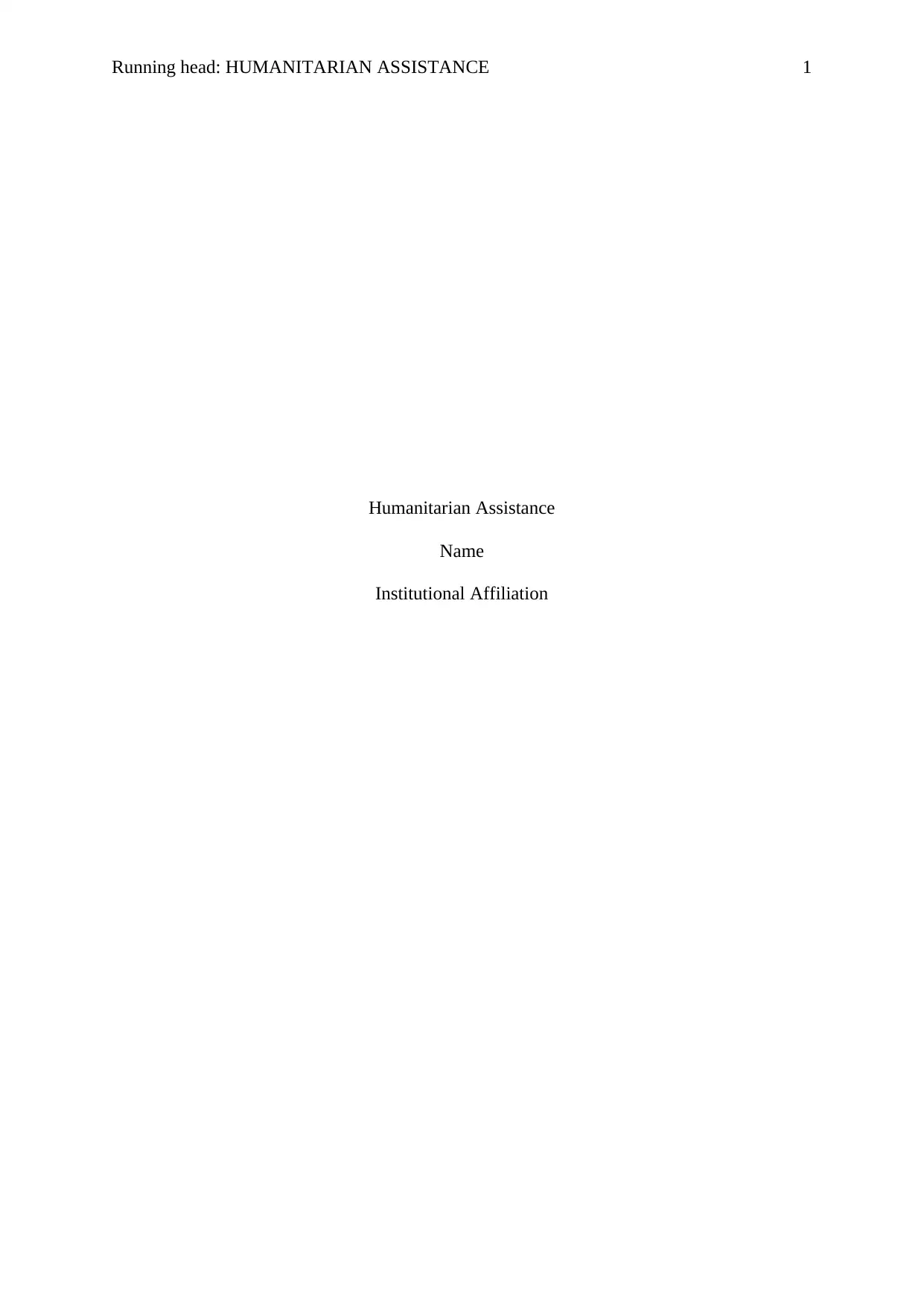
Running head: HUMANITARIAN ASSISTANCE 1
Humanitarian Assistance
Name
Institutional Affiliation
Humanitarian Assistance
Name
Institutional Affiliation
Secure Best Marks with AI Grader
Need help grading? Try our AI Grader for instant feedback on your assignments.
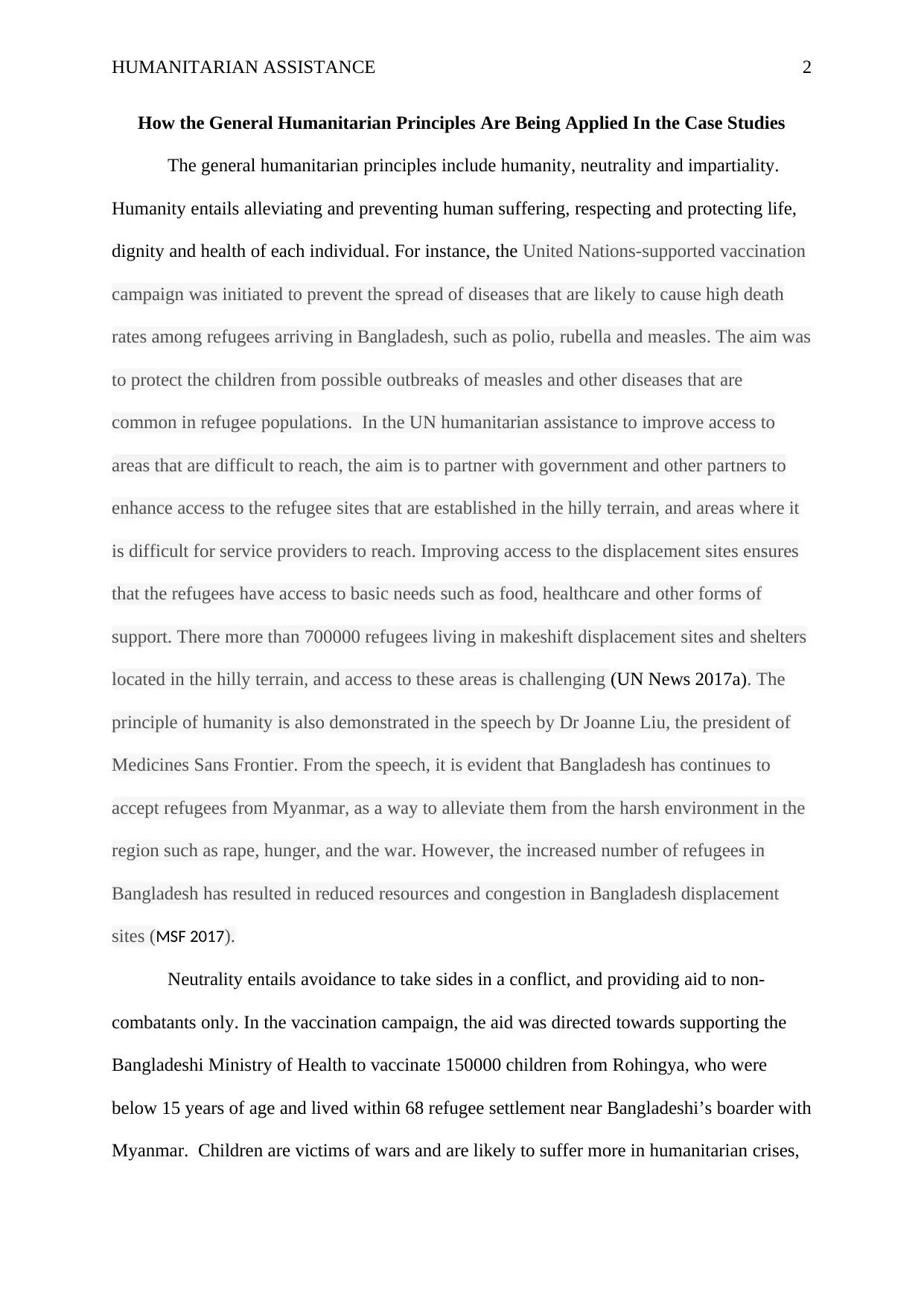
HUMANITARIAN ASSISTANCE 2
How the General Humanitarian Principles Are Being Applied In the Case Studies
The general humanitarian principles include humanity, neutrality and impartiality.
Humanity entails alleviating and preventing human suffering, respecting and protecting life,
dignity and health of each individual. For instance, the United Nations-supported vaccination
campaign was initiated to prevent the spread of diseases that are likely to cause high death
rates among refugees arriving in Bangladesh, such as polio, rubella and measles. The aim was
to protect the children from possible outbreaks of measles and other diseases that are
common in refugee populations. In the UN humanitarian assistance to improve access to
areas that are difficult to reach, the aim is to partner with government and other partners to
enhance access to the refugee sites that are established in the hilly terrain, and areas where it
is difficult for service providers to reach. Improving access to the displacement sites ensures
that the refugees have access to basic needs such as food, healthcare and other forms of
support. There more than 700000 refugees living in makeshift displacement sites and shelters
located in the hilly terrain, and access to these areas is challenging (UN News 2017a). The
principle of humanity is also demonstrated in the speech by Dr Joanne Liu, the president of
Medicines Sans Frontier. From the speech, it is evident that Bangladesh has continues to
accept refugees from Myanmar, as a way to alleviate them from the harsh environment in the
region such as rape, hunger, and the war. However, the increased number of refugees in
Bangladesh has resulted in reduced resources and congestion in Bangladesh displacement
sites (MSF 2017).
Neutrality entails avoidance to take sides in a conflict, and providing aid to non-
combatants only. In the vaccination campaign, the aid was directed towards supporting the
Bangladeshi Ministry of Health to vaccinate 150000 children from Rohingya, who were
below 15 years of age and lived within 68 refugee settlement near Bangladeshi’s boarder with
Myanmar. Children are victims of wars and are likely to suffer more in humanitarian crises,
How the General Humanitarian Principles Are Being Applied In the Case Studies
The general humanitarian principles include humanity, neutrality and impartiality.
Humanity entails alleviating and preventing human suffering, respecting and protecting life,
dignity and health of each individual. For instance, the United Nations-supported vaccination
campaign was initiated to prevent the spread of diseases that are likely to cause high death
rates among refugees arriving in Bangladesh, such as polio, rubella and measles. The aim was
to protect the children from possible outbreaks of measles and other diseases that are
common in refugee populations. In the UN humanitarian assistance to improve access to
areas that are difficult to reach, the aim is to partner with government and other partners to
enhance access to the refugee sites that are established in the hilly terrain, and areas where it
is difficult for service providers to reach. Improving access to the displacement sites ensures
that the refugees have access to basic needs such as food, healthcare and other forms of
support. There more than 700000 refugees living in makeshift displacement sites and shelters
located in the hilly terrain, and access to these areas is challenging (UN News 2017a). The
principle of humanity is also demonstrated in the speech by Dr Joanne Liu, the president of
Medicines Sans Frontier. From the speech, it is evident that Bangladesh has continues to
accept refugees from Myanmar, as a way to alleviate them from the harsh environment in the
region such as rape, hunger, and the war. However, the increased number of refugees in
Bangladesh has resulted in reduced resources and congestion in Bangladesh displacement
sites (MSF 2017).
Neutrality entails avoidance to take sides in a conflict, and providing aid to non-
combatants only. In the vaccination campaign, the aid was directed towards supporting the
Bangladeshi Ministry of Health to vaccinate 150000 children from Rohingya, who were
below 15 years of age and lived within 68 refugee settlement near Bangladeshi’s boarder with
Myanmar. Children are victims of wars and are likely to suffer more in humanitarian crises,
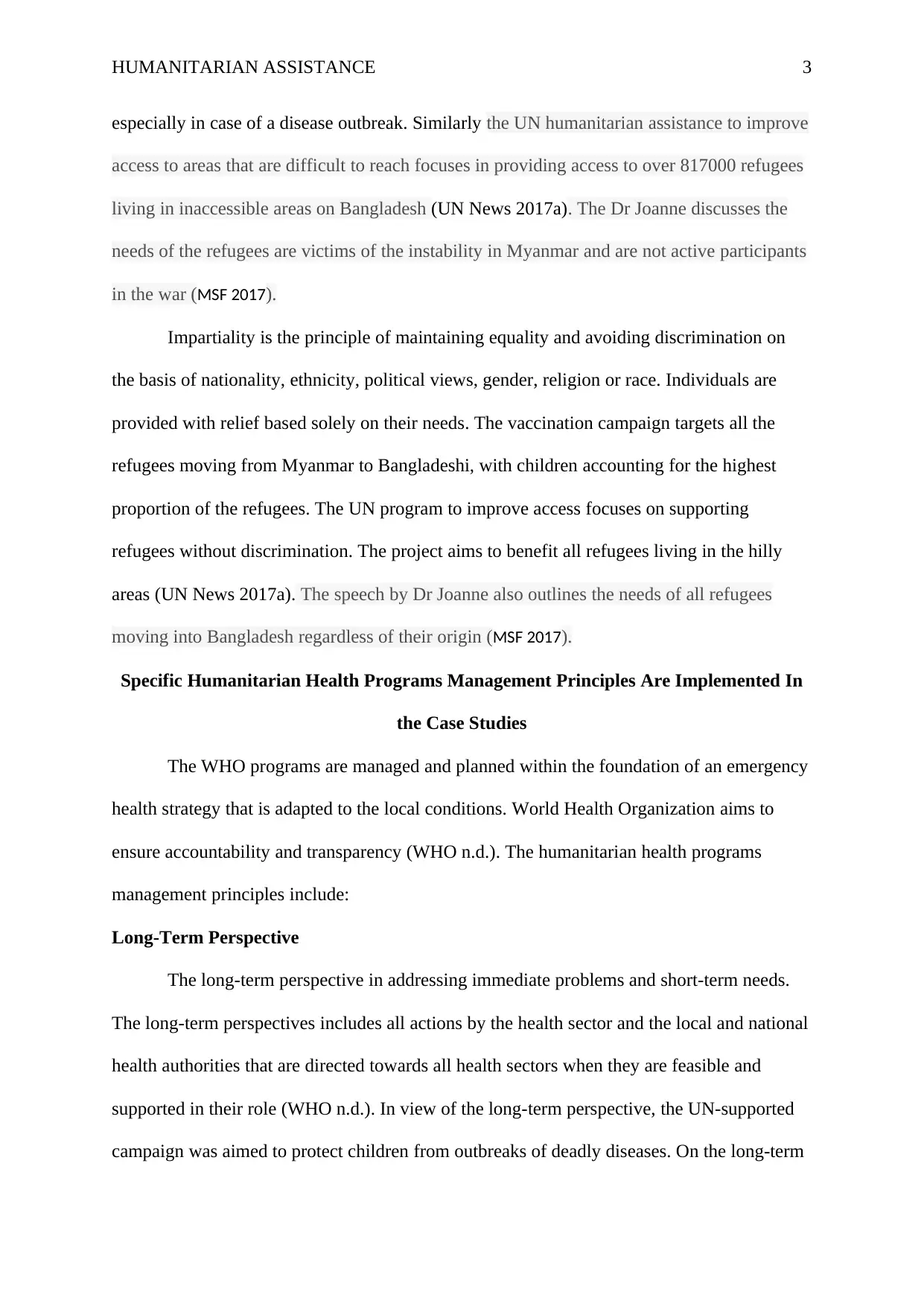
HUMANITARIAN ASSISTANCE 3
especially in case of a disease outbreak. Similarly the UN humanitarian assistance to improve
access to areas that are difficult to reach focuses in providing access to over 817000 refugees
living in inaccessible areas on Bangladesh (UN News 2017a). The Dr Joanne discusses the
needs of the refugees are victims of the instability in Myanmar and are not active participants
in the war (MSF 2017).
Impartiality is the principle of maintaining equality and avoiding discrimination on
the basis of nationality, ethnicity, political views, gender, religion or race. Individuals are
provided with relief based solely on their needs. The vaccination campaign targets all the
refugees moving from Myanmar to Bangladeshi, with children accounting for the highest
proportion of the refugees. The UN program to improve access focuses on supporting
refugees without discrimination. The project aims to benefit all refugees living in the hilly
areas (UN News 2017a). The speech by Dr Joanne also outlines the needs of all refugees
moving into Bangladesh regardless of their origin (MSF 2017).
Specific Humanitarian Health Programs Management Principles Are Implemented In
the Case Studies
The WHO programs are managed and planned within the foundation of an emergency
health strategy that is adapted to the local conditions. World Health Organization aims to
ensure accountability and transparency (WHO n.d.). The humanitarian health programs
management principles include:
Long-Term Perspective
The long-term perspective in addressing immediate problems and short-term needs.
The long-term perspectives includes all actions by the health sector and the local and national
health authorities that are directed towards all health sectors when they are feasible and
supported in their role (WHO n.d.). In view of the long-term perspective, the UN-supported
campaign was aimed to protect children from outbreaks of deadly diseases. On the long-term
especially in case of a disease outbreak. Similarly the UN humanitarian assistance to improve
access to areas that are difficult to reach focuses in providing access to over 817000 refugees
living in inaccessible areas on Bangladesh (UN News 2017a). The Dr Joanne discusses the
needs of the refugees are victims of the instability in Myanmar and are not active participants
in the war (MSF 2017).
Impartiality is the principle of maintaining equality and avoiding discrimination on
the basis of nationality, ethnicity, political views, gender, religion or race. Individuals are
provided with relief based solely on their needs. The vaccination campaign targets all the
refugees moving from Myanmar to Bangladeshi, with children accounting for the highest
proportion of the refugees. The UN program to improve access focuses on supporting
refugees without discrimination. The project aims to benefit all refugees living in the hilly
areas (UN News 2017a). The speech by Dr Joanne also outlines the needs of all refugees
moving into Bangladesh regardless of their origin (MSF 2017).
Specific Humanitarian Health Programs Management Principles Are Implemented In
the Case Studies
The WHO programs are managed and planned within the foundation of an emergency
health strategy that is adapted to the local conditions. World Health Organization aims to
ensure accountability and transparency (WHO n.d.). The humanitarian health programs
management principles include:
Long-Term Perspective
The long-term perspective in addressing immediate problems and short-term needs.
The long-term perspectives includes all actions by the health sector and the local and national
health authorities that are directed towards all health sectors when they are feasible and
supported in their role (WHO n.d.). In view of the long-term perspective, the UN-supported
campaign was aimed to protect children from outbreaks of deadly diseases. On the long-term
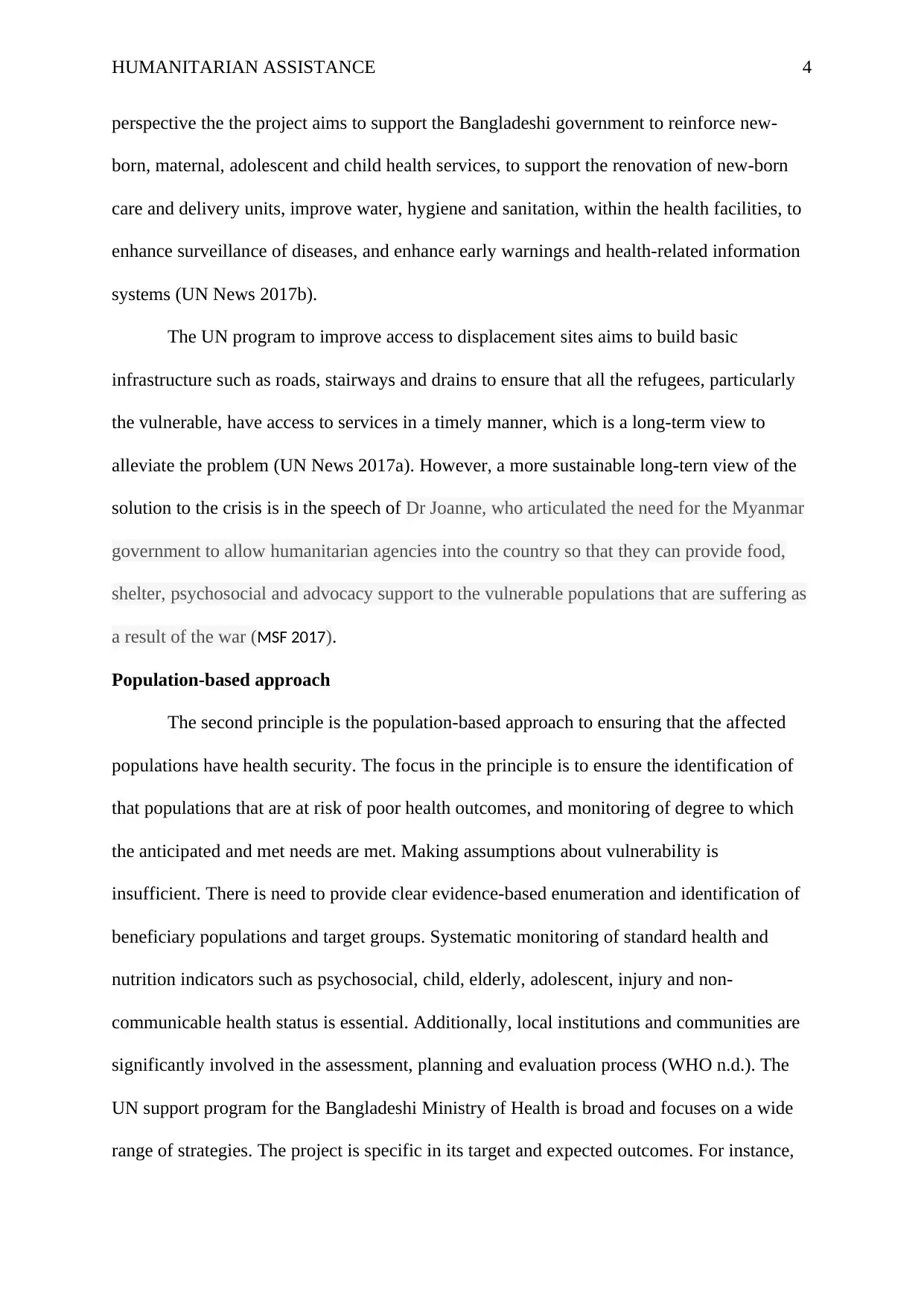
HUMANITARIAN ASSISTANCE 4
perspective the the project aims to support the Bangladeshi government to reinforce new-
born, maternal, adolescent and child health services, to support the renovation of new-born
care and delivery units, improve water, hygiene and sanitation, within the health facilities, to
enhance surveillance of diseases, and enhance early warnings and health-related information
systems (UN News 2017b).
The UN program to improve access to displacement sites aims to build basic
infrastructure such as roads, stairways and drains to ensure that all the refugees, particularly
the vulnerable, have access to services in a timely manner, which is a long-term view to
alleviate the problem (UN News 2017a). However, a more sustainable long-tern view of the
solution to the crisis is in the speech of Dr Joanne, who articulated the need for the Myanmar
government to allow humanitarian agencies into the country so that they can provide food,
shelter, psychosocial and advocacy support to the vulnerable populations that are suffering as
a result of the war (MSF 2017).
Population-based approach
The second principle is the population-based approach to ensuring that the affected
populations have health security. The focus in the principle is to ensure the identification of
that populations that are at risk of poor health outcomes, and monitoring of degree to which
the anticipated and met needs are met. Making assumptions about vulnerability is
insufficient. There is need to provide clear evidence-based enumeration and identification of
beneficiary populations and target groups. Systematic monitoring of standard health and
nutrition indicators such as psychosocial, child, elderly, adolescent, injury and non-
communicable health status is essential. Additionally, local institutions and communities are
significantly involved in the assessment, planning and evaluation process (WHO n.d.). The
UN support program for the Bangladeshi Ministry of Health is broad and focuses on a wide
range of strategies. The project is specific in its target and expected outcomes. For instance,
perspective the the project aims to support the Bangladeshi government to reinforce new-
born, maternal, adolescent and child health services, to support the renovation of new-born
care and delivery units, improve water, hygiene and sanitation, within the health facilities, to
enhance surveillance of diseases, and enhance early warnings and health-related information
systems (UN News 2017b).
The UN program to improve access to displacement sites aims to build basic
infrastructure such as roads, stairways and drains to ensure that all the refugees, particularly
the vulnerable, have access to services in a timely manner, which is a long-term view to
alleviate the problem (UN News 2017a). However, a more sustainable long-tern view of the
solution to the crisis is in the speech of Dr Joanne, who articulated the need for the Myanmar
government to allow humanitarian agencies into the country so that they can provide food,
shelter, psychosocial and advocacy support to the vulnerable populations that are suffering as
a result of the war (MSF 2017).
Population-based approach
The second principle is the population-based approach to ensuring that the affected
populations have health security. The focus in the principle is to ensure the identification of
that populations that are at risk of poor health outcomes, and monitoring of degree to which
the anticipated and met needs are met. Making assumptions about vulnerability is
insufficient. There is need to provide clear evidence-based enumeration and identification of
beneficiary populations and target groups. Systematic monitoring of standard health and
nutrition indicators such as psychosocial, child, elderly, adolescent, injury and non-
communicable health status is essential. Additionally, local institutions and communities are
significantly involved in the assessment, planning and evaluation process (WHO n.d.). The
UN support program for the Bangladeshi Ministry of Health is broad and focuses on a wide
range of strategies. The project is specific in its target and expected outcomes. For instance,
Secure Best Marks with AI Grader
Need help grading? Try our AI Grader for instant feedback on your assignments.
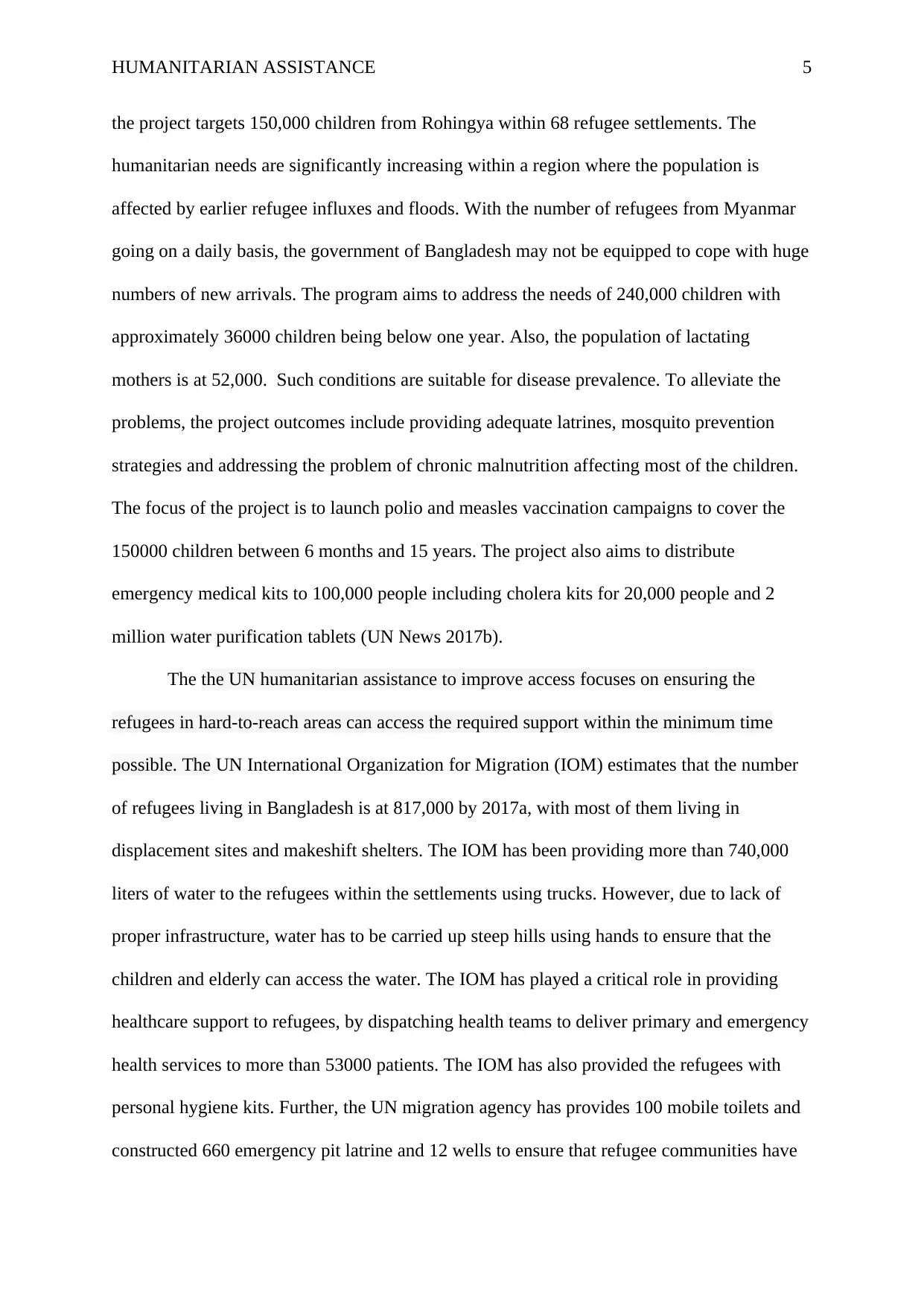
HUMANITARIAN ASSISTANCE 5
the project targets 150,000 children from Rohingya within 68 refugee settlements. The
humanitarian needs are significantly increasing within a region where the population is
affected by earlier refugee influxes and floods. With the number of refugees from Myanmar
going on a daily basis, the government of Bangladesh may not be equipped to cope with huge
numbers of new arrivals. The program aims to address the needs of 240,000 children with
approximately 36000 children being below one year. Also, the population of lactating
mothers is at 52,000. Such conditions are suitable for disease prevalence. To alleviate the
problems, the project outcomes include providing adequate latrines, mosquito prevention
strategies and addressing the problem of chronic malnutrition affecting most of the children.
The focus of the project is to launch polio and measles vaccination campaigns to cover the
150000 children between 6 months and 15 years. The project also aims to distribute
emergency medical kits to 100,000 people including cholera kits for 20,000 people and 2
million water purification tablets (UN News 2017b).
The the UN humanitarian assistance to improve access focuses on ensuring the
refugees in hard-to-reach areas can access the required support within the minimum time
possible. The UN International Organization for Migration (IOM) estimates that the number
of refugees living in Bangladesh is at 817,000 by 2017a, with most of them living in
displacement sites and makeshift shelters. The IOM has been providing more than 740,000
liters of water to the refugees within the settlements using trucks. However, due to lack of
proper infrastructure, water has to be carried up steep hills using hands to ensure that the
children and elderly can access the water. The IOM has played a critical role in providing
healthcare support to refugees, by dispatching health teams to deliver primary and emergency
health services to more than 53000 patients. The IOM has also provided the refugees with
personal hygiene kits. Further, the UN migration agency has provides 100 mobile toilets and
constructed 660 emergency pit latrine and 12 wells to ensure that refugee communities have
the project targets 150,000 children from Rohingya within 68 refugee settlements. The
humanitarian needs are significantly increasing within a region where the population is
affected by earlier refugee influxes and floods. With the number of refugees from Myanmar
going on a daily basis, the government of Bangladesh may not be equipped to cope with huge
numbers of new arrivals. The program aims to address the needs of 240,000 children with
approximately 36000 children being below one year. Also, the population of lactating
mothers is at 52,000. Such conditions are suitable for disease prevalence. To alleviate the
problems, the project outcomes include providing adequate latrines, mosquito prevention
strategies and addressing the problem of chronic malnutrition affecting most of the children.
The focus of the project is to launch polio and measles vaccination campaigns to cover the
150000 children between 6 months and 15 years. The project also aims to distribute
emergency medical kits to 100,000 people including cholera kits for 20,000 people and 2
million water purification tablets (UN News 2017b).
The the UN humanitarian assistance to improve access focuses on ensuring the
refugees in hard-to-reach areas can access the required support within the minimum time
possible. The UN International Organization for Migration (IOM) estimates that the number
of refugees living in Bangladesh is at 817,000 by 2017a, with most of them living in
displacement sites and makeshift shelters. The IOM has been providing more than 740,000
liters of water to the refugees within the settlements using trucks. However, due to lack of
proper infrastructure, water has to be carried up steep hills using hands to ensure that the
children and elderly can access the water. The IOM has played a critical role in providing
healthcare support to refugees, by dispatching health teams to deliver primary and emergency
health services to more than 53000 patients. The IOM has also provided the refugees with
personal hygiene kits. Further, the UN migration agency has provides 100 mobile toilets and
constructed 660 emergency pit latrine and 12 wells to ensure that refugee communities have
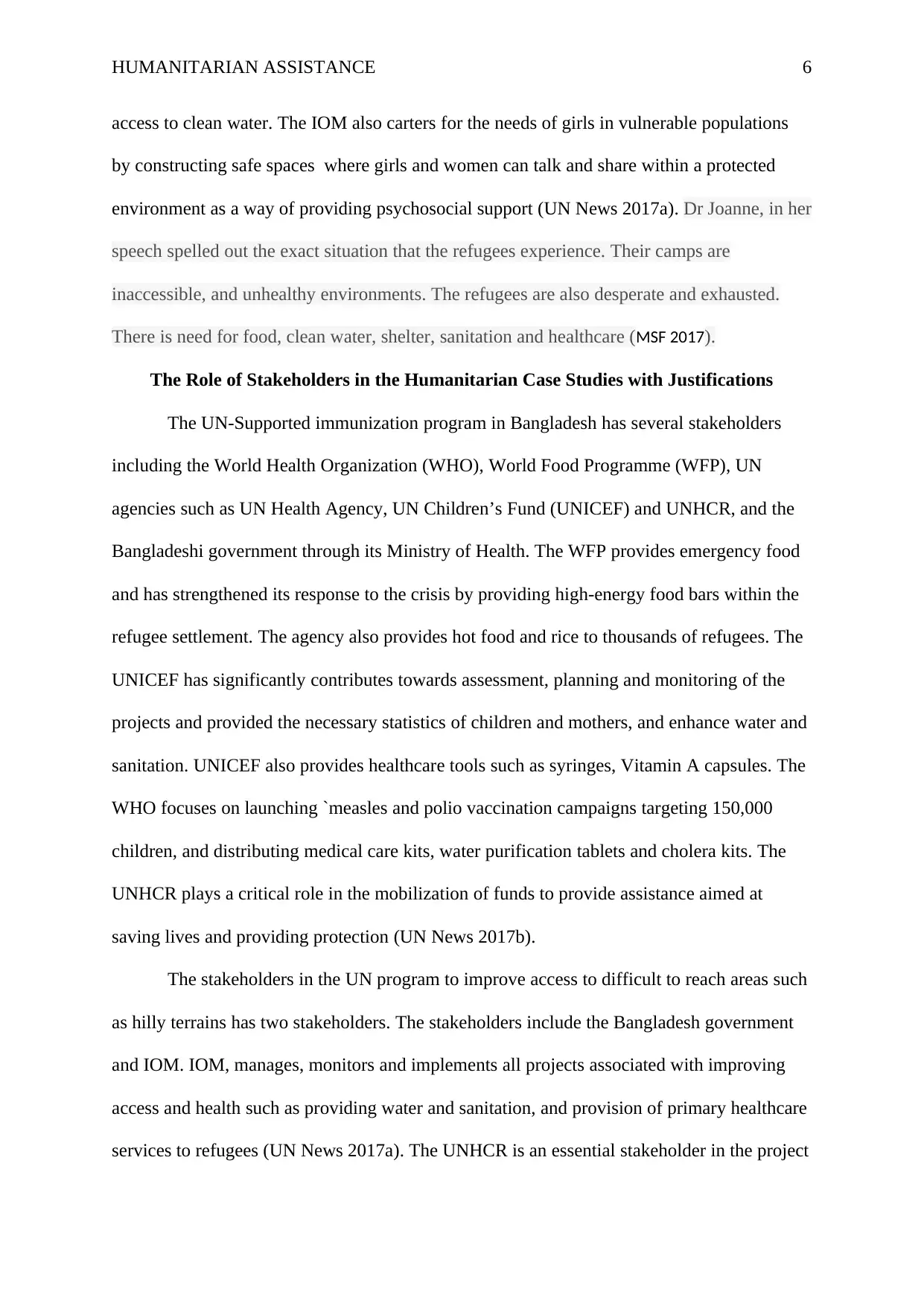
HUMANITARIAN ASSISTANCE 6
access to clean water. The IOM also carters for the needs of girls in vulnerable populations
by constructing safe spaces where girls and women can talk and share within a protected
environment as a way of providing psychosocial support (UN News 2017a). Dr Joanne, in her
speech spelled out the exact situation that the refugees experience. Their camps are
inaccessible, and unhealthy environments. The refugees are also desperate and exhausted.
There is need for food, clean water, shelter, sanitation and healthcare (MSF 2017).
The Role of Stakeholders in the Humanitarian Case Studies with Justifications
The UN-Supported immunization program in Bangladesh has several stakeholders
including the World Health Organization (WHO), World Food Programme (WFP), UN
agencies such as UN Health Agency, UN Children’s Fund (UNICEF) and UNHCR, and the
Bangladeshi government through its Ministry of Health. The WFP provides emergency food
and has strengthened its response to the crisis by providing high-energy food bars within the
refugee settlement. The agency also provides hot food and rice to thousands of refugees. The
UNICEF has significantly contributes towards assessment, planning and monitoring of the
projects and provided the necessary statistics of children and mothers, and enhance water and
sanitation. UNICEF also provides healthcare tools such as syringes, Vitamin A capsules. The
WHO focuses on launching `measles and polio vaccination campaigns targeting 150,000
children, and distributing medical care kits, water purification tablets and cholera kits. The
UNHCR plays a critical role in the mobilization of funds to provide assistance aimed at
saving lives and providing protection (UN News 2017b).
The stakeholders in the UN program to improve access to difficult to reach areas such
as hilly terrains has two stakeholders. The stakeholders include the Bangladesh government
and IOM. IOM, manages, monitors and implements all projects associated with improving
access and health such as providing water and sanitation, and provision of primary healthcare
services to refugees (UN News 2017a). The UNHCR is an essential stakeholder in the project
access to clean water. The IOM also carters for the needs of girls in vulnerable populations
by constructing safe spaces where girls and women can talk and share within a protected
environment as a way of providing psychosocial support (UN News 2017a). Dr Joanne, in her
speech spelled out the exact situation that the refugees experience. Their camps are
inaccessible, and unhealthy environments. The refugees are also desperate and exhausted.
There is need for food, clean water, shelter, sanitation and healthcare (MSF 2017).
The Role of Stakeholders in the Humanitarian Case Studies with Justifications
The UN-Supported immunization program in Bangladesh has several stakeholders
including the World Health Organization (WHO), World Food Programme (WFP), UN
agencies such as UN Health Agency, UN Children’s Fund (UNICEF) and UNHCR, and the
Bangladeshi government through its Ministry of Health. The WFP provides emergency food
and has strengthened its response to the crisis by providing high-energy food bars within the
refugee settlement. The agency also provides hot food and rice to thousands of refugees. The
UNICEF has significantly contributes towards assessment, planning and monitoring of the
projects and provided the necessary statistics of children and mothers, and enhance water and
sanitation. UNICEF also provides healthcare tools such as syringes, Vitamin A capsules. The
WHO focuses on launching `measles and polio vaccination campaigns targeting 150,000
children, and distributing medical care kits, water purification tablets and cholera kits. The
UNHCR plays a critical role in the mobilization of funds to provide assistance aimed at
saving lives and providing protection (UN News 2017b).
The stakeholders in the UN program to improve access to difficult to reach areas such
as hilly terrains has two stakeholders. The stakeholders include the Bangladesh government
and IOM. IOM, manages, monitors and implements all projects associated with improving
access and health such as providing water and sanitation, and provision of primary healthcare
services to refugees (UN News 2017a). The UNHCR is an essential stakeholder in the project
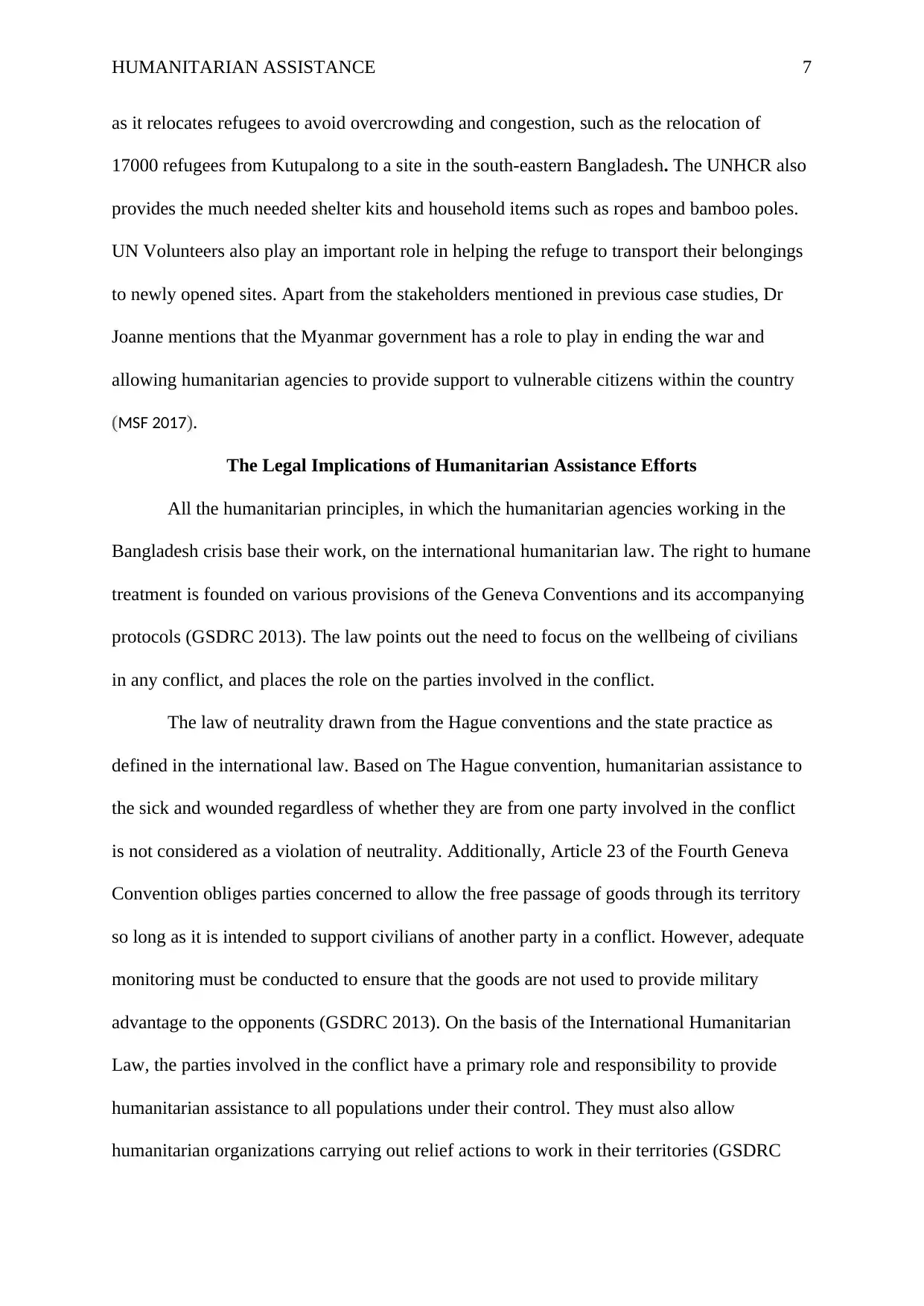
HUMANITARIAN ASSISTANCE 7
as it relocates refugees to avoid overcrowding and congestion, such as the relocation of
17000 refugees from Kutupalong to a site in the south-eastern Bangladesh. The UNHCR also
provides the much needed shelter kits and household items such as ropes and bamboo poles.
UN Volunteers also play an important role in helping the refuge to transport their belongings
to newly opened sites. Apart from the stakeholders mentioned in previous case studies, Dr
Joanne mentions that the Myanmar government has a role to play in ending the war and
allowing humanitarian agencies to provide support to vulnerable citizens within the country
(MSF 2017).
The Legal Implications of Humanitarian Assistance Efforts
All the humanitarian principles, in which the humanitarian agencies working in the
Bangladesh crisis base their work, on the international humanitarian law. The right to humane
treatment is founded on various provisions of the Geneva Conventions and its accompanying
protocols (GSDRC 2013). The law points out the need to focus on the wellbeing of civilians
in any conflict, and places the role on the parties involved in the conflict.
The law of neutrality drawn from the Hague conventions and the state practice as
defined in the international law. Based on The Hague convention, humanitarian assistance to
the sick and wounded regardless of whether they are from one party involved in the conflict
is not considered as a violation of neutrality. Additionally, Article 23 of the Fourth Geneva
Convention obliges parties concerned to allow the free passage of goods through its territory
so long as it is intended to support civilians of another party in a conflict. However, adequate
monitoring must be conducted to ensure that the goods are not used to provide military
advantage to the opponents (GSDRC 2013). On the basis of the International Humanitarian
Law, the parties involved in the conflict have a primary role and responsibility to provide
humanitarian assistance to all populations under their control. They must also allow
humanitarian organizations carrying out relief actions to work in their territories (GSDRC
as it relocates refugees to avoid overcrowding and congestion, such as the relocation of
17000 refugees from Kutupalong to a site in the south-eastern Bangladesh. The UNHCR also
provides the much needed shelter kits and household items such as ropes and bamboo poles.
UN Volunteers also play an important role in helping the refuge to transport their belongings
to newly opened sites. Apart from the stakeholders mentioned in previous case studies, Dr
Joanne mentions that the Myanmar government has a role to play in ending the war and
allowing humanitarian agencies to provide support to vulnerable citizens within the country
(MSF 2017).
The Legal Implications of Humanitarian Assistance Efforts
All the humanitarian principles, in which the humanitarian agencies working in the
Bangladesh crisis base their work, on the international humanitarian law. The right to humane
treatment is founded on various provisions of the Geneva Conventions and its accompanying
protocols (GSDRC 2013). The law points out the need to focus on the wellbeing of civilians
in any conflict, and places the role on the parties involved in the conflict.
The law of neutrality drawn from the Hague conventions and the state practice as
defined in the international law. Based on The Hague convention, humanitarian assistance to
the sick and wounded regardless of whether they are from one party involved in the conflict
is not considered as a violation of neutrality. Additionally, Article 23 of the Fourth Geneva
Convention obliges parties concerned to allow the free passage of goods through its territory
so long as it is intended to support civilians of another party in a conflict. However, adequate
monitoring must be conducted to ensure that the goods are not used to provide military
advantage to the opponents (GSDRC 2013). On the basis of the International Humanitarian
Law, the parties involved in the conflict have a primary role and responsibility to provide
humanitarian assistance to all populations under their control. They must also allow
humanitarian organizations carrying out relief actions to work in their territories (GSDRC
Paraphrase This Document
Need a fresh take? Get an instant paraphrase of this document with our AI Paraphraser
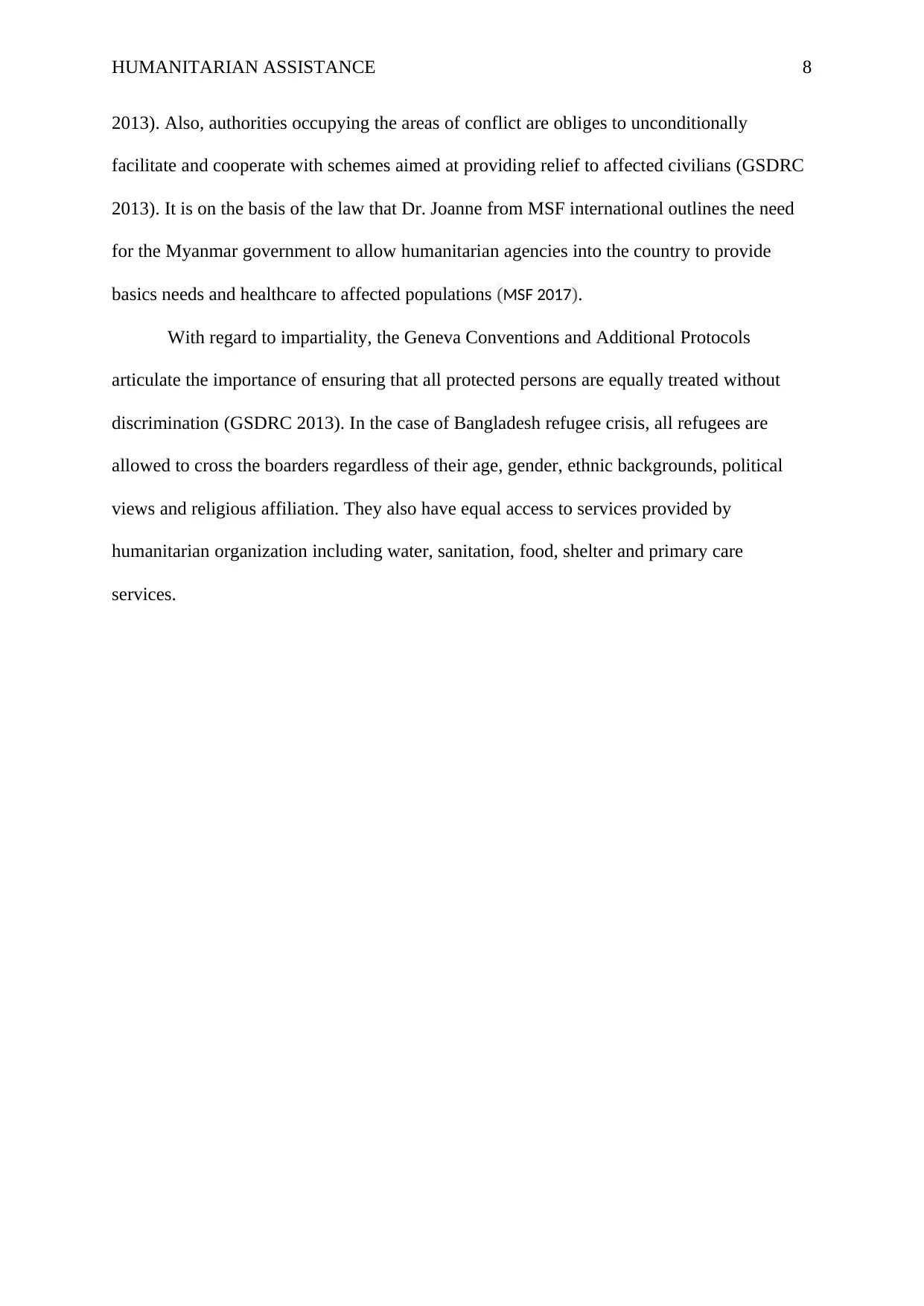
HUMANITARIAN ASSISTANCE 8
2013). Also, authorities occupying the areas of conflict are obliges to unconditionally
facilitate and cooperate with schemes aimed at providing relief to affected civilians (GSDRC
2013). It is on the basis of the law that Dr. Joanne from MSF international outlines the need
for the Myanmar government to allow humanitarian agencies into the country to provide
basics needs and healthcare to affected populations (MSF 2017).
With regard to impartiality, the Geneva Conventions and Additional Protocols
articulate the importance of ensuring that all protected persons are equally treated without
discrimination (GSDRC 2013). In the case of Bangladesh refugee crisis, all refugees are
allowed to cross the boarders regardless of their age, gender, ethnic backgrounds, political
views and religious affiliation. They also have equal access to services provided by
humanitarian organization including water, sanitation, food, shelter and primary care
services.
2013). Also, authorities occupying the areas of conflict are obliges to unconditionally
facilitate and cooperate with schemes aimed at providing relief to affected civilians (GSDRC
2013). It is on the basis of the law that Dr. Joanne from MSF international outlines the need
for the Myanmar government to allow humanitarian agencies into the country to provide
basics needs and healthcare to affected populations (MSF 2017).
With regard to impartiality, the Geneva Conventions and Additional Protocols
articulate the importance of ensuring that all protected persons are equally treated without
discrimination (GSDRC 2013). In the case of Bangladesh refugee crisis, all refugees are
allowed to cross the boarders regardless of their age, gender, ethnic backgrounds, political
views and religious affiliation. They also have equal access to services provided by
humanitarian organization including water, sanitation, food, shelter and primary care
services.
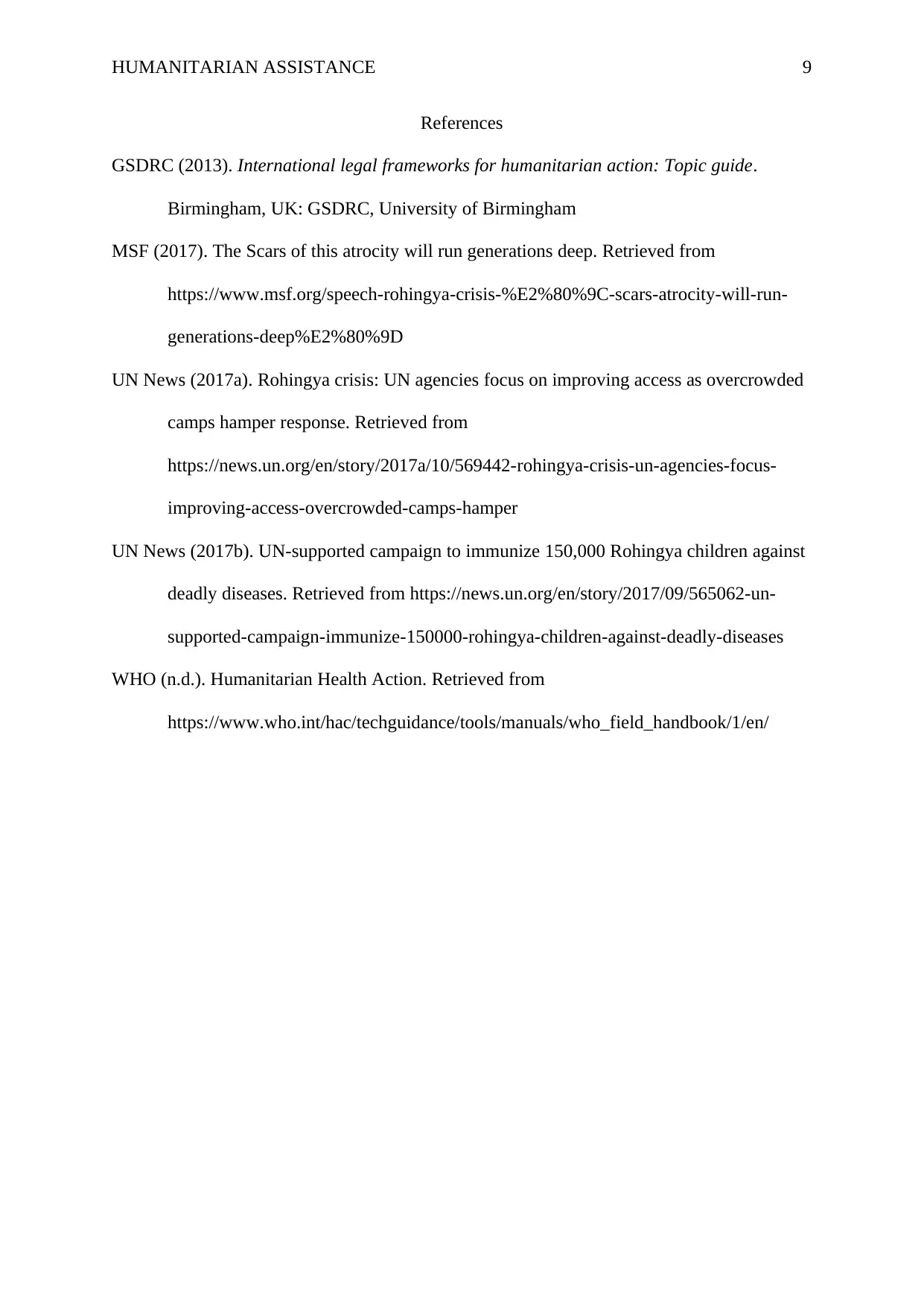
HUMANITARIAN ASSISTANCE 9
References
GSDRC (2013). International legal frameworks for humanitarian action: Topic guide.
Birmingham, UK: GSDRC, University of Birmingham
MSF (2017). The Scars of this atrocity will run generations deep. Retrieved from
https://www.msf.org/speech-rohingya-crisis-%E2%80%9C-scars-atrocity-will-run-
generations-deep%E2%80%9D
UN News (2017a). Rohingya crisis: UN agencies focus on improving access as overcrowded
camps hamper response. Retrieved from
https://news.un.org/en/story/2017a/10/569442-rohingya-crisis-un-agencies-focus-
improving-access-overcrowded-camps-hamper
UN News (2017b). UN-supported campaign to immunize 150,000 Rohingya children against
deadly diseases. Retrieved from https://news.un.org/en/story/2017/09/565062-un-
supported-campaign-immunize-150000-rohingya-children-against-deadly-diseases
WHO (n.d.). Humanitarian Health Action. Retrieved from
https://www.who.int/hac/techguidance/tools/manuals/who_field_handbook/1/en/
References
GSDRC (2013). International legal frameworks for humanitarian action: Topic guide.
Birmingham, UK: GSDRC, University of Birmingham
MSF (2017). The Scars of this atrocity will run generations deep. Retrieved from
https://www.msf.org/speech-rohingya-crisis-%E2%80%9C-scars-atrocity-will-run-
generations-deep%E2%80%9D
UN News (2017a). Rohingya crisis: UN agencies focus on improving access as overcrowded
camps hamper response. Retrieved from
https://news.un.org/en/story/2017a/10/569442-rohingya-crisis-un-agencies-focus-
improving-access-overcrowded-camps-hamper
UN News (2017b). UN-supported campaign to immunize 150,000 Rohingya children against
deadly diseases. Retrieved from https://news.un.org/en/story/2017/09/565062-un-
supported-campaign-immunize-150000-rohingya-children-against-deadly-diseases
WHO (n.d.). Humanitarian Health Action. Retrieved from
https://www.who.int/hac/techguidance/tools/manuals/who_field_handbook/1/en/
1 out of 9
Your All-in-One AI-Powered Toolkit for Academic Success.
+13062052269
info@desklib.com
Available 24*7 on WhatsApp / Email
![[object Object]](/_next/static/media/star-bottom.7253800d.svg)
Unlock your academic potential
© 2024 | Zucol Services PVT LTD | All rights reserved.


